Moulting chickens with FAQ and pictures.
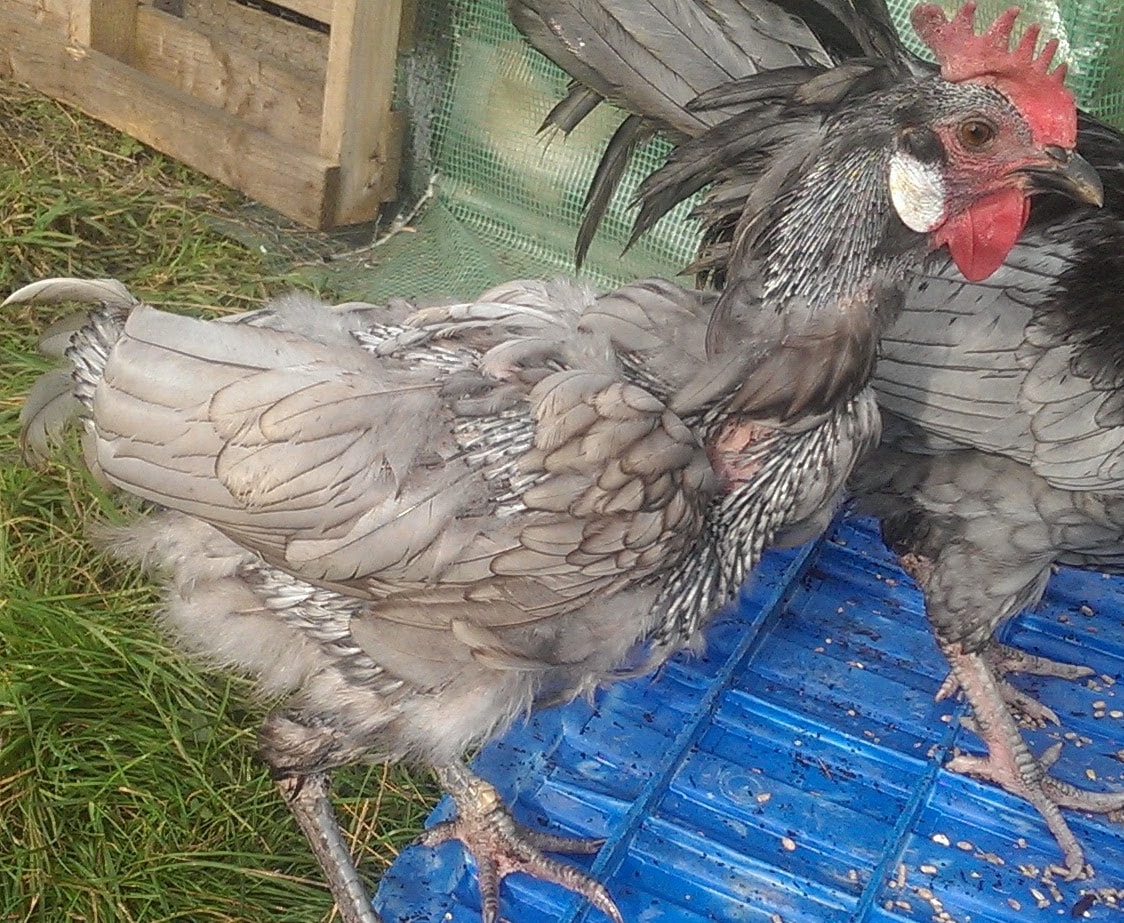
I can remember my first moulting chickens, I opened the coop doors one morning in October and there were feathers everywhere and around half of the hens had varying stages of feather loss. I had been warned about the moult but I wasn't really prepared for what it would look like and how fast it can happen.
One of the more worrying things to see as a new poultry keeper is chickens going through a moult, it can look like a fox has been at your hens and there can be feathers everywhere in the coop or run.
Table of Contents
- What is moulting?
- Why do chickens moult?
- The moulting process:
- What time of year do chickens moult?
- How long does moulting last in chickens?
- What helps moulting chickens?
- Feather pecking during the moult:
- What should you feed moulting chickens?
- Moulting FAQ:
- What looks like moulting but is not?
- Moulting in chicks and young chickens:
- What not to do with moulting chickens:
- How To Care For Your Moulting Chickens:
- How do you know when the moult is over?
- Stress and moulting:
- What is forced moulting?
Chicken replace their old feathers in a pattern controlled by hormones and triggered by the shortening days in the autumn or the fall. Every individual bird passes through this phase of renewal and rejuvenation of the reproductive system to some extent.
Most chickens shed their feathers in late summer or early autumn and the process is normally all over by November. Moulting is a completely natural process which nearly all birds go through on a yearly cycle. The only treatment you need to provide is supportive care and monitoring as it can be a difficult time for the hens.
During a moult chickens would normally stop laying eggs and use this time to build up their energy, nutrient and mineral reserves as well as getting a new coat of feathers.
Below: Moulting varies with each chicken and from year to year.
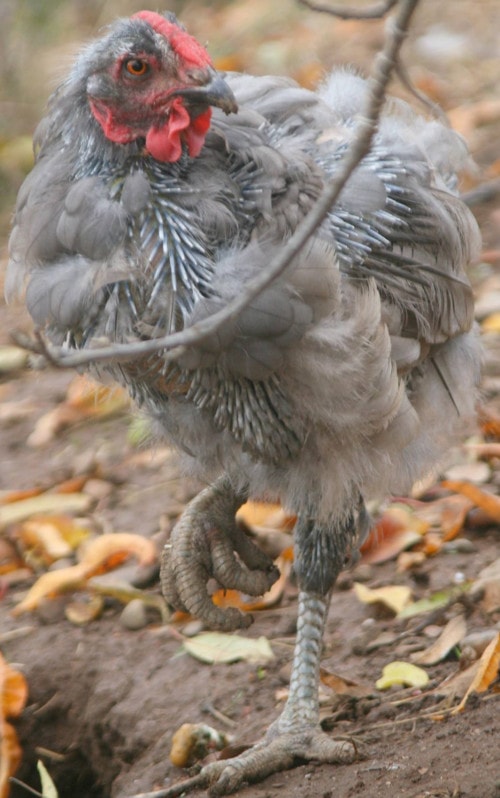
All feathers get damaged during use, faded and cracked in the sun and look a little tatty over the course of a year. This is especially true if you have a rooster, you will notice your hens have bald patches on their backs. It is necessary for birds to replace feathers just when they need them most for protection from the elements and insulation from the cold.
If you have trimmed wing feathers to stop your chickens from flying, you will need to do this again after the moult has finished.
Take great care not to clip the feathers either too early in their new growth period or too short since there is blood inside the quill of a feather when it is growing and if it is cut too soon, it will bleed profusely and be very difficult to stop.
Feathers whose quills are full of blood will appear dark or almost black instead of the clear or white of normal shafts.
What is moulting?
Moulting is the process of shedding and renewing feathers and allowing the reproductive physiology of the bird is allowed a complete rest from laying and letting the chicken builds up its body reserves, nutrients and constitution.
As a rule all chickens change all or most of their feathers every year, the moulting (molting in USA) usually happens in autumn or the fall around October and November as they change their feathers. In general the laying of eggs stops for most chickens during the moult but this is not always the case.
Below: A chicken in the middle of the moult.
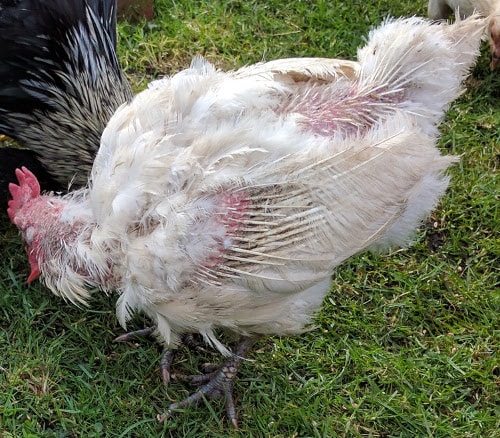
The feathers look dull and the birds look a bit haggard for 4 to 5 weeks as they change their feathers. In my experience the chickens never moult at the same time and is staggered over a few weeks, it seems to be that the hens that have been broody and/or raised a brood during the year will lay eggs a bit later in the year and moult a bit later.
The first sign of a moult is erratic egg production and then the shedding of feathers. This is followed by the appearance of the new pins, short stubble that the feathers grow through.
Why do chickens moult?
Chickens moult to replace old, worn and damaged feathers with shiny new ones that will protect them and keep them warm.
Both hens and roosters moult. Young chickens or growers will go through three partial and one complete juvenile moult and their first adult moult will occur at 16-18 months of age depending on when they were hatched.
It is the shortening of day length that triggers the moult and not the cold as is sometimes believed
Chickens moult to:
- Replace damaged and broken feathers.
- Regrow feathers in the brood patch and worn feathers from mating.
- Take a rest from laying to rebuild mineral, nutrient and energy reserves.
- Restore egg quality and so fertility.
Moulting is a natural part of a chickens life cycle where they lose feathers and start to grow new ones.
The most visible part of moulting will be your chickens losing their feathers. This gives them a ragged, unkempt look that can be quite shocking to owners the first time they see it. It’s a natural part of the process and not something to be worried about.
The other defining characteristic of moulting is that your hens will usually stop laying. They’re directing everything they can to nutrient reserves and producing new feathers, which are 85% protein.
How many feathers are lost, and how long it takes to grow them back is variable between chickens. Some lose just a few feather, while some lose loads. Growing new feathers can take between 3-16 weeks, varying with the breed and increasing with the age of the chicken.
Moulting Cockerels - Like hens, cockerels also moult, and while in this condition are nearly always infertile due to loss of body weight and because their reproductive physiology is undergoing a resting phase. Care must be taken to ensure that cockerels do not lose more than 25% of their body weight while moulting as this can lead to sterility.
The moulting process:
Moulting takes place in a fairly definite order that is sometimes not all that easy to see.
The first plumage is lost from the head and neck, then from the saddle, breast and abdomen, then the wings and then from the tail.
Primary feathers are shed first from the axial feather outwards to the end of the wing. Number 1 primary feather is first to drop followed by a number 2 and then in order to number 10. While the primaries are being shed the secondaries begin to drop but not in any set order,
While the first feathers are being dropped from the neck and body, good layers will often keep laying, but when the wing feathers begin to drop, laying usually ceases.
The main wing feathers consist of four tiny finger feathers on the extreme tip of the wing, then ten large primary or "flight" feathers, the small axial feather, and the fourteen secondary feathers, which are smaller and softer than the primaries.
Below: Hybrids and ex-battery hens often moult in extreme ways and need extra care.
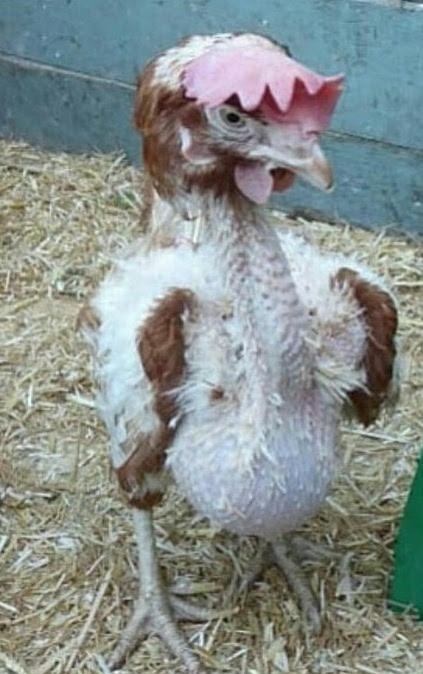
When the wing moults, primary feathers are shed first, from the axial outwards to the end of the wing, and then the secondaries, which are not shed in such a set order as the primaries.
The axial feather is dropped at the same time as the secondary next to it. The new quill starts to grow as soon as the old feather is out and takes approximately six to seven weeks to grow.
The moult is complete when all primary flight feathers on the wing are replaced. The feathers of the moulted bird are large and full, softer, cleaner, brighter and glossy in contrast to the feathers before moulting which were small and hard, dry, frayed and tattered.
When the moult starts the birds hormonal system is activated and the Thyroid gland undergoes a series of changes that play a key role. The replacement of old feathers is under the control of thyroid hormone known as T3.
During the moulting process, metabolic rate may increase from 40-50% that can lead to higher body temperature as compared to the normal bird temperature. This higher body temperature is necessary to maintain the body temperature when the old feathers are shed.
Chickens replace their feathers in this sequence:
- Head
- Neck
- Breast
- Back
- Fluff
- Abdomen
- Wings
- Tail feather
The whole process is mainly controlled by the hypothalamus under the anterior pituitary gland and as a result the chicken reduces its body weight up to 20-30%.
What time of year do chickens moult?
Chicken are most likely to moult after the autumn equinox and before winter starts. It is at this time of year that the day length falls below 12 hours of light and triggers the hormonal changes in chickens that begin the moulting process.
Some birds may start a week or two before and a few stragglers may go a week or two after but most will be done around this time.
In the UK this date is around the third week of September.
How long does moulting last in chickens?
Heritage chickens or pure breeds take longer to moult than modern hybrid hens. Sometimes hens will lay into the moult but most will take a break and as it progresses the plumage will begin to look dull and ragged.
The moult normally takes about 3 to 6 weeks for a young healthy pure breed hen to complete a moult. Older hens may take 2 months to complete. Wild chickens still need to be able to escape from predators so they do not lose all of their flight feathers at the same time. Modern hybrids tend to moult more quickly.
What helps moulting chickens?
A dust bath will help no end and should be provided.
Bad cases of the moult will require so protection from the elements, You can't help but feel a little sorry for birds like this Andalusian above that has lost nearly all it's feathers at the same time.
Some high calorie and high protein feed will help but try and keep carbohydrates lower as a high carbohydrate diet can interfere with new feather growth and slow it down.
Feather pecking during the moult:
The way feathers regrow during the moult can leave birds vulnerable to feather pecking.
There are several reason why they peck feathers but sometimes it is out of boredom and in extreme cases if chickens are not getting enough protein, they will peck at other birds feathers and eat them in order to increase their protein levels.
Birds are very vulnerable at this time with bare skin showing and since it doesn't take much for a wound to appear and chickens love to peck at red blood exasperating the problem. You should always separate a bird if blood is visible.
Below: New pin feathers shows new pins growing.
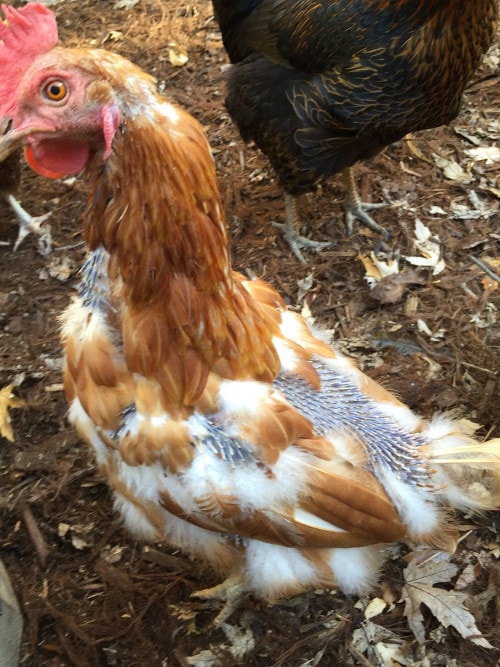
What should you feed moulting chickens?
During the moult a chickens need for calories increases by around a quarter or 25% and they also require more protein in the diet. The average chicken will need about 5 to 8 grams of protein a day during the moult to make sure they don't lose condition.
To much can be bad for the kidneys and a waste so choose feed supplements like shelled sunflower seeds that are rich in calories and have the protein needed.
Growing new feathers require protein so when birds moult, laying hens will usually stop producing eggs. Eggs are made up mainly of protein and it is too much for a hen to produce new feathers as well as eggs. There is a calorie demand during the moult as well and birds will eat more especially if you are in a part of the world where autumn is very cold.
Along these lines, during moulting you’ll want to limit scratch to no more than 10% of their diet. Scratch doesn’t have much protein, but chickens love it. If more is available they’ll fill up on it and not get enough high protein feed.
Some poultry keepers supplement their birds diets with additional protein. Yeast extract, sometimes called dried brewers malt, and sunflower seeds are an excellent addition to the died as is mixed corn or split maize depending on where you are from, it is easily digestible and quite energy dense. Suet pellets of the type you would feed to your garden birds will help with the calorie debt during the moult.
You need to bear in mind that there are laws in Europe which govern what you can feed to your chickens. You are much better advised to buy a sack of turkey ration for use during the moult as it has a much higher protein content.
Due to their increased protein needs, it’s worthwhile to increase the amount in their feed. One option is to buy a high protein feed, usually around 20-22% protein.
This will sometimes be called “feature grower”, “feather fixer” or “game bird / show bird”. If you don’t want to buy speciality food, its possible to increase their protein consumption by adding some dried cat or dog food, bone and bits of meat, or freeze dried mealworm. In all cases, you don’t want to go crazy. Having too much protein can be hard on a chicken’s kidneys and could CAUSE health problems.
Apple Cider Vinegar can easily be added to their water to help them through this difficult time. Molasses can be bought from any feed store and can be given in small quantities.
Moulting FAQ:
Do chickens eat more or less feed when moulting?
Chickens require between 20 and 30% more calories and 5 to 8 grams more protein a day during the moult. They may stay in the coop during this time for much longer than they normally would.
Can you stop a chicken moulting?
No, It is governed by the day length and hormonal changes and once it has started it cannot be stopped. In commercial chicken and egg operations the hens have a minimum of 16 hours light in 24 to make sure they do not moult.
Do some chickens need special care when moulting?
Ex battery hens can often go through an extended moult lasting up to six weeks when they are taken out of the battery environment and can be almost completely bald and will probably need to be kept indoors.
You need to bear in mind that battery hens may have been put through a forced moult which involves withholding food and sometimes water till they change their feathers.
Do all chickens moult at the same time?
No. Mine stagger themselves over 6 to 8 weeks at the end of the year. They always seem to be done by December.
Do chickens bleed when they moult?
They should not bleed but it is an occasional thing if the new pin feathers are bumped or knocked or pecked at by another bird. They are sensitive and bleed more easily at this time.
How can you tell if a chicken is moulting?
It may be lethargic and stay near the food. 95% of chickens stop laying completely when they moult and they will lose varying amounts of their old feathers.
It may well have trouble flying up to the perches.
Chickens sometimes act differently when they are moulting and tend to stand around in the coop a lot.
Her bright red comb will likely lose its colour and go quite pale for a few weeks.
Do hens lay eggs when moulting?
Some do. Most stop and lay none at all but a few will produce the odd one. I don't think I have ever had a chicken in my flock that has laid normally during the moult. Most of my birds are heritage varieties and nor hybrids although I do have a few modern types.
Can a chicken die from moulting?
Yes they can. Moulting is a stressful time and it is easy for the chickens to fall prey to opportune diseases and they are less able to escape predators.
Are chickens less productive after a moult?
Yes. After moulting, the second year of egg production will be between 10 and 30% less than that achieved by the birds in their first year of lay. This is because the rate of lay is lower and the birds cease to lay earlier in the following autumn.
Birds which have moulted twice and are laying for their third year will lay only 70 to 80% of their second years eggs ie. about 60% of their first years production.
What looks like moulting but is not?
Feathers that are lost or pulled out tend to regrow as needed. When the feathers regrow the first appear as a pin or quill through which the feather emerges and this can be painful for the bird as well as annoying.
Amorous roosters can cause bald patches of the back of the neck and above the tail on the back and you should investigate any unusual feather loss.
Brood patches. This is the bare patch on the breast of a hen that has been broody.
Grabbing a chicken can result in a bald patch.
Feather loss due to mites, lice or parasites.
Moulting in chicks and young chickens:
Chicks are slightly different, they go through 3 partial and one full moult before reaching laying age and this happens regardless of the time of year.
The chick goes through one complete and three partial moults during its growth to point of lay, after which the mature bird normally undergoes one complete moult a year, usually in autumn although this depends on the time of the year at which the bird commenced laying.
Generally complete moulting occurs from 1-6 weeks and partial moulting at 7-9 weeks, 12-16 weeks and 20-22 weeks, when during this latter moult, the stiff tail feathers are grown.
This young Barnevelder chick has lost a few feathers as part of it's natural growth cycle and looks a little tatty.
Below: A moulting Barnevelder chick.
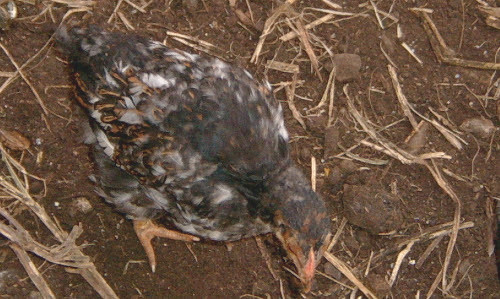
Chicks go through 3 partial and 1 full moult before the are fully grown but this happens gradually and the youngsters still carry plenty of feathers. and all hens replace some or all of their feathers every year.
Chickens that go into moult will lose their old feathers and new feathers will grow in the place of old. It can happen very quickly so the birds can look almost naked or oven ready. It can a little shocking because birds will often look very scruffy. A partial moult can sometimes take place earlier on in the year although this is usually just the head and neck feathers that are replaced.
What not to do with moulting chickens:
I have seen a few things recommended (I don't recommend them) like cat or dog food as a good source of protein and a handful of this a few times a week can help top up your birds protein levels. This is now illegal in the EU and UK and isn't a good idea anyway. Lots of cat food is fish based and contains mercury.
Don't overdo the protein, a little everyday is much better than big doses occasionally.
We supplement the hens diet from autumn with a few extra ounces of shelled or husked sunflower and safflower seeds.
They may also need some extra protein if they are not allowed to range and a draught free and sheltered spot so as they don't get cold while they have gaps in their feathers as some birds can be almost bald. If this is the case they may need some special care if the weather is particularly bad or cold
A dust bath is essential at this stage, helping to both remove the old feathers and assisting with the emergence of the new ones.
How To Care For Your Moulting Chickens:
Moulting is inherently stressful for chickens, so you don’t want to do anything that will add more stress to their lives at this time. Moving them, introducing new birds to the flock or handling them are all high-stress events that should be avoided.
Their growing feathers are very sensitive and being handled will be painful to the birds.
If you have multiple chickens moulting at the same time you can end up with a large numbers of feathers. A chicken can have thousands of feathers. These can be added to a compost heap, used for cat toys or thrown in the garbage.
Physical Exhaustion - Your chicken may have been laying continuously for for 10 or 11 months and just as the shortening day length resulting in reduced feeding time, they start to change their feathers which can lead to a loss of body weight and condition.
Feathers are protein in character and are more easily grown when laying ceases, because of the birds difficulty in assimilating sufficient protein for both egg and feather production. During the moult the fowl still requires a considerable amount of good quality food to replace feathers and build up condition.
The difference between a rapid and slow moulter is not due to a difference in growth rate of the individual feather, but because the rapid moulter renews a large number of feathers at the same time.
How do you know when the moult is over?
The presence of new emerging feathers or pin feathers usually indicates the moult is entering it's final stage as the new feathers grow.
When the moult is over the chicken will have a new coat of feathers that will look nice and even and cover her completely and her comb will begin to redden up and swell a little as her condition returns.
She will become more active and begin to roam and forage further away again.
The moult is complete when all primary flight feathers on the wing are replaced.
Stress and moulting:
Moults can occur any time due to chickens being subjected to stress.
Poultry becomes stressed when the environment presents a problem to which the bird cannot respond without suffering a harmful effect, much the same as humans.
The following are common stress factors which can induce moulting:
- Lighting - decreasing daylight, decreasing artificial light.
- Loss of body weight.
- Disease or Internal parasites.
- Climate - excessive cold or heat.
- Deficiencies of essential ingredients; irregular feeding; insufficient feed.
- Predators eg. cats and dogs or Fright - wild birds and children.
- Bottom of the peck ordering.
- Prolonged broodiness.
- Overcrowding, flock movement, water deprivation, faulty ventilation, wet litter, debeaking, vaccinations, exposed housing, etc.
What is forced moulting?
Forced moulting is a technique that is used in commercial flocks to induce a bird to replace its feathers and prepare it for a new laying cycle. Various methods or combinations are used including drugs, starvation and very short daylights cycles.
Force moulting is a practise not normally applicable to the household situation. Natural moulting is slower and more erratic than force moulting.
Systematic starvation of chickens is inhumane, and many birds die during forced moult because their immune system is depleted. That can make them, and their eggs, susceptible to salmonella.
Induced moulting is desirable:
- When the cost of replacing flock is higher,
- Feed cost is higher,
- Egg market prices are less,
- Moulting depends on the economic condition of the individual farm and flock.
Advantages of forced/induced moulting:
- Reduce replacement cost per dozens of eggs.
- Production is improved within a shorter duration.
- Egg quality and quantity can be improved.
- Feed efficiency can be improved.
- We can obtain less, small eggs .
Disadvantages of forced/induced moulting:
- Rate of production is less as compared to new pullets in a year.
- In induced moulting flock, there is a rapid rate of decline in egg quality.
- The higher percentage of misshaping of eggs.
- Handling cost is more.
- The mortality rate may be higher.
- Too few birds may be retained maximum egg production in the following year.
Force moulting is a practice adopted by some commercial egg producers to bring about a rapid moult so that all the birds come back into lay for a second time at a certain time of the year, usually in autumn.
It is achieved by subjecting a flock to a combination of mild environmental stress factors causing the birds to cease laying and consequently moult.
